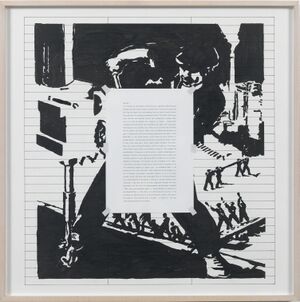Letters to the Red Crayola XII, 1977-2012
| Letters to the Red Crayola XII, 1977-2012 | |
|---|---|
 | |
| Art & Language | |
| Project | |
| Year | 2012 |
| Dimensions | 51.8 × 71 cm[1] |
| Materials | Ink, acrylic, collage and mixed media on paper |
Text
Dear M, As it turned out, the karaoke worked best in a small and rather informal looking room that easily became crowded. There was far more attack and brio from the singers who were standing close, not only to friends, but also to people who were nodding acquaintances at best. The effect of the larger room with the cool furniture, posters and contemporary reading matter was, as we did not predict, less conducive to singers — except rather competent and self-assured ones, including Gina Birch who sang along, following her own recorded voice. What can we tell from this? Possibly that the people who sang in Nantes were not British and therefore not quite as tight-assed as the more reluctant performers in London. I don't think that's a strong reason, as the French are not at all keen on looking foolish — and a karaoke performance is ipso facto foolish. Could it be that in the small space, where singers rubbed shoulders with others, there was a sense of mutual complicity, that the neighbours of the singers whose bodies made contact were somehow joining in? Well, perhaps the quantification of joiners-in is not the point. A certain embarrassment, a joining-in at the tip of the tongue, hut not quite achieved, is in some ways culturally superior to a jolly sing-along. But it's hardly news to say there's deflation in frustration. The karaoke text has something of the 'Index' works about it. It comes in strips and in colours and it is annotated by its own theoretical progress as (sung) lyric — as something finally to be produced by the voice. The index works might have been produced as a sort of karaoke conversation, annotated so as to be quasi-operatic. In fact, the quite often implausible lyrics of 'Corrected Slogans' are as much attached to the indexes as they are to our later and more sober reflections. (And there has to be some connection between the lyrics themselves and the levels of embarrassment and alienation available: 'That's when your heartaches begin' vs. 'Jackson Pollock was the artist of the Marshall Plan', vs. 'Hey there, you with the stars in your eyes'.) You could also say that the music of 'Corrected Slogans' crackles with some of the madness of the index-ing talk. It includes — or factors in — the dogs whose barking joins the conversation.
Interpretations
- The text discusses
 Karaoke Bar (2005), Index 003 Bxal (1974),
Karaoke Bar (2005), Index 003 Bxal (1974),  Corrected Slogans (1976), Portrait of V. I. Lenin in the Style of Jackson Pollock, Part I (1980)
Corrected Slogans (1976), Portrait of V. I. Lenin in the Style of Jackson Pollock, Part I (1980) - The background image references one of the posters in Ten Posters: Illustrations for Art-Language (1977)